| Tendulkar - Childhood  |
| Young Tendulkar Batting  |
| Tendulkar with School team  |
| Tendulkar with childhood friends  |
| Tendulkar with Kapil Dev & Azharuddin  |
| Young Sachin Bowling  |
| Raising his bat  |
| Attitude..  |
| Coy..  |
Thursday, April 1, 2010
Photos of Young Sachin Tendulkar
Comparison of batting records of Sachin Tendulkar with those of Brian Lara & Ricky Ponting
- Sachin Tendulkar is the clear leader in ODIs.
- In test matches, Lara has the highest score in a single innings, Ponting leads in average and Tendulkar leads in centuries (100s) scored!
- Tendulkar is now the largest run-scorer in the world! He is the first cricketer to score 12,000 runs in test match cricket!!
| Name | Country | Matches | Runs | Average | Highest | 50s | 100s |
|---|---|---|---|---|---|---|---|
| Sachin Tendulkar | India | 428 | 16,895 | 44.57 | 186* | 91 | 44 |
| Brian Lara | West Indies | 299 | 10,405 | 40.48 | 169 | 63 | 19 |
| Ricky Ponting | Australia | 318 | 11,703 | 42.71 | 164 | 67 | 27 |
| Name | Country | Matches | Runs | Average | Highest | 50s | 100s |
|---|---|---|---|---|---|---|---|
| Sachin Tendulkar | India | 159 | 12,773 | 54.58 | 248* | 53 | 42 |
| Brian Lara | West Indies | 131 | 11,953 | 52.88 | 400* | 48 | 34 |
| Ricky Ponting | Australia | 136 | 11,345 | 55.88 | 257 | 48 | 38 |
Records & Achievements of Sachin
- Highest number of Test centuries (39), overtaking Sunil Gavaskar's record (34) on 10 December 2005 vs Sri Lanka in Delhi
- Fastest to score 10,000 runs in Test cricket history. He holds this record along with Brian Lara. Both of them achieved this feat in 195 innings.
- 4th highest tally of runs in Test cricket (10,668)
- Career Average 55.70 - highest average among those who have scored over 10,000 Test runs
- Second Indian to make over 10,000 runs in Test matches
Highlights of Tendulkar's ODI (One Day Internationals) career
- Highest ODI run-scorer in the world with 16,007 aggregate ODI runs (as of 05-Feb-2008)
- 41 ODI centuries - highest in the world
- Played most number of ODIs (409) (as of 05-Feb-2008)
- Played most number of consecutive ODI matches (185 matches from Sharjah, 1989/90 to Sharjah, 1997/98)
- Most Man of the Match (53!) awards
- Appeared on the most grounds (90 different grounds)
- Most ODI runs by any batsman in any given calendar year - 1,894 ODI runs in 1998
- Most Centuries by a player in one year - 9 ODI centuries in 1998
- Most centuries vs. Australia, South Africa, New Zealand, Sri Lanka and Zimbabwe.
- Holds the record for scoring 1,000 ODI runs in a calendar year. He has done it six times - 1994, 1996, 1997, 1998, 2000 and 2003.
- First and the fastest cricketer to cross 10,000-run mark, 11,000-run mark, 12,000-run mark, 13,000 run-mark and 14,000 run-mark in ODIs. The only player to have scored over 16,000 runs till-date
- Only cricketer to cross 14,000-run mark in ODIs
- One of only six players to pass 10,000 runs in ODIs (Sanath Jayasuriya, Sourav Ganguly, Rahul Dravid, Brian Lara, and Inzamam ul Haq are the others)
- Highest individual score among Indian batsmen (186* against New Zealand at Hyderabad in 1999)
Tendulkar's World Cup History & Records
- Most runs (1,732 at an average of 59.72) in World Cup Cricket History
- 673 runs in 2003 Cricket World Cup, highest by any player in a single Cricket World Cup
- Player Of The World Cup Tournament in the 2003 Cricket World Cup.
Favourites of Tendulkar
Movie : Coming to America
Music : Pop
Hobby : Collecting CD's.
Car : Maruti
Actors : Amitabh Bacchan, Nana Patekar
Actresses : Madhuri Dixit
Cricket Heroes : Gavaskar, Viv Richards, Imran Khan and Sandeep Patil
Other Fav. Stars : Maradona, Borris Becker
Drink : Orange / Apple juice and water
Food : Steak
Pastime : Listening to peaceful music with friends
Clothes : Official jacket and tie, else jeans and T-shirt
Magazine : Sportstar
Newspapers : Times of India, Mid-day, Afternoon Dispatch
Restaurant : Bukhara, Maurya Sheraton
Holiday Resort : Yorkshire, Headingley
Hotel : Park Royal Darling Harbour, Sydney
Other Sports : Tennis
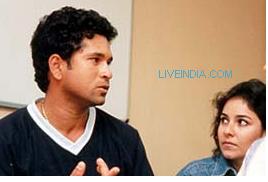
First step towards cricket
Achrekar ( Cricket Coach ). Sachin failed to perform in the first go which made him very nervous but his brother's
persuasion led Mr. Achrekar give him another chance.
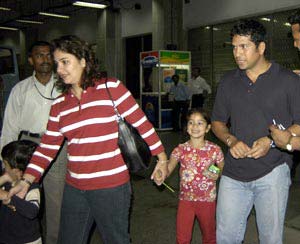
career under the guidance of his coach and mentor, Ramakant Achrekar. During his school days,
he attended the MRF Pace Foundation to train as a fast bowler, but the fast bowling trainer there,
Dennis Lillee, suggested to him to "just focus" on his batting.
When Tendulkar was young, he would practice for hours with his coach. He would often get bored
of practicing. So his coach would put a one-Rupee-coin on the top of the stumps.
The bowler who dismissed Sachin would get the coin. If Sachin passed the whole session without
getting dismissed, the coach would give him the coin. Sachin says today that the
13 coins he won then are his most prized possessions.
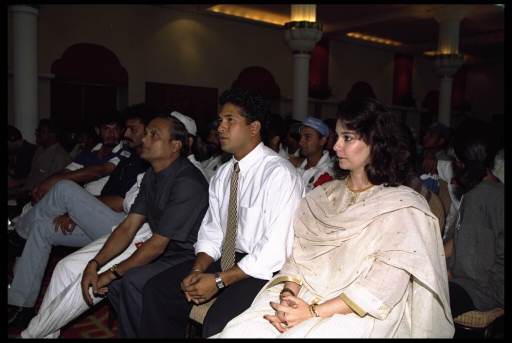
It was his change of school to Shardashram Vidya Mandir in Dadar - close to Shivaji Park on his coach's advice
which marked a turn around in Sachin's career. He says," I use to bat in four nets at one strech. Whenever, I use
to get tired, Achrekar use to keep a one rupee coin on top of the stumps and say, "Anyone who gets him out will
take this coin. If no-one gets him, Sachin takes it." Tendulkar till date contributes this technique in being
instrumental for enhancing his concentration. He still treasures the 13 coins earned by him during the practice
sessions.
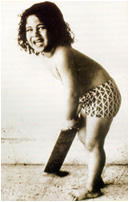 | 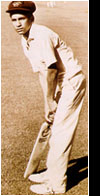 |
Naughty Duo
Sachin and his best pal Vinod Kambli hold the World Record of 664 runs stand for Shardashram School in
inter-school tournament in 1988. Tendulkar candidly admits that the total would have never assumed mammoth
proportion had he and Kambli not ignored the man waving from the boundary with the coach's message to
declare.

Tendulkar's idol is the American Tennis superstar-John McEnore. During his young age, he argued and fought for
McEnore with his colony friends who supported Swedish Bjorn Borg. Sachin sported a head-band, sweat-band
and a tennis racquet showing his staunch loyalty towards his idol.
Family Quirks
Sachin's wife Anjali tends to become nervous while he bats, whereas his brother has become so superstitious
that he allows the family members to only watch the match recording.
His reactions to his dismissals
On pre-mature and early exits, Sachin likes to take out his anger somewhere. He prefers to be left alone, till he
cools down.
Sachin's greatest hits
Sachin's greatest hits 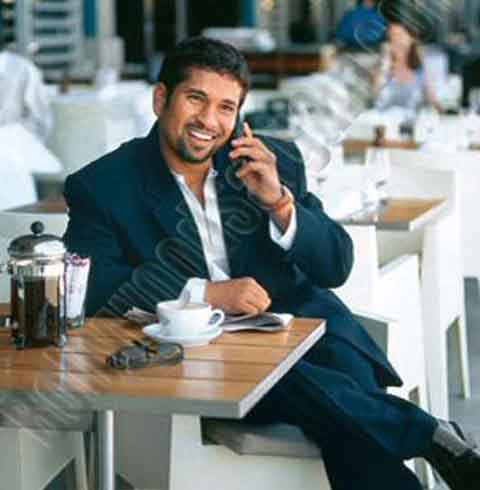
1990
At the age of 17, Tendulkar reaches three figures for the first time in a Test as he makes 119 not out against England at Old Trafford. The innings includes 17 fours but the match is drawn.
1992
Tendulkar shows the Australian fans what he is capable of by batting almost five hours for an unbeaten 148 in the third Test at Sydney, but once again the game is drawn.
The following match in Perth sees him make 114 off 161 balls, with 16 fours, but India are beaten by 300 runs.
Tendulkar is a class apart as he makes 111 out of an Indian first innings total of 227 against South Africa in Johannesburg and at 19 years and 217 days becomes the youngest player to reach 1,000 Test runs.
1993
England are on the receiving end as Tendulkar scores his first century on home soil, hitting a six and 24 fours in his 165 as India win by an innings and 22 runs in Madras.
Next up are Sri Lanka and Tendulkar's second innings 104 not out helps India to a 235-run victory in Colombo.
1994
Tendulkar returns home to face Sri Lanka again and it is a similar story as he collects 22 boundaries in a first innings score of 142 at Lucknow as India triumph by an innings and 119 runs.
The year comes to an end with a home series against West Indies and Tendulkar defies Courtney Walsh and co for almost seven hours to make 179 in Nagpur. The game ends in a draw.
1996
Tendulkar is in brilliant form on his second tour to England, marking the start of a three-match series with 122 at Edgbaston, but he is unable to prevent the home side from winning by eight wickets.
The third match at Nottingham sees Tendulkar score 177, including 26 fours, and he shares a stand of 255 with Sourav Ganguly. The match, however, ends in a draw.
1997
India are beaten 2-0 in South Africa at the start of the year, but Tendulkar marks the second Test in Cape Town with a score of 169, which features 26 boundaries.
Tendulkar makes Sri Lanka suffer again by making 143 in an Indian total of 537 for eight declared in Colombo, but the game is drawn.
The second Test follows a similar pattern with Tendulkar this time batting for six and a half hours to reach 139.
There is no let-up for the Sri Lankans as they travel to India only to suffer another Tendulkar onslaught - 148 including three sixes and 20 fours in Bombay, but they escape with a draw.
1998
Australia visit India in early 1998 and Tendulkar greets Mark Taylor's men by hitting fours sixes and 14 fours in his 155 not out at Madras as India win by 179 runs.
He does even better in the third Test at Bangalore with an innings of 177, but Australia prevent a clean sweep with an eight wicket win.
Tendulkar makes his first Test hundred against New Zealand, but his 113 cannot save India from a four-wicket defeat.
Arch-rivals Pakistan visit India and Tendulkar helps himself to 136 in Madras, only for India to lose an exciting match by 12 runs.
1999
Once again Tendulkar feasts on Sri Lanka's bowling, making 124 not out in the drawn Test in Colombo.
India return home to play New Zealand and Tendulkar scores 126 not out in the drawn Test at Chandigarh.
A landmark innings in the third Test sees Tendulkar make 217, his first Test double century, in a 344-ball innings which includes 29 boundaries.
India are outplayed in Australia at the end of the year, but Tendulkar shows his class by scoring 116 in the second Test at Melbourne. The home side win the game, however, by 180 runs.
2000
Tendulkar plays the supporting role to Rahul Dravid with 122 as India beat Zimbabwe by seven wickets in Delhi. Dravid scores 200 not out.
It is Tendulkar's turn to double up in Nagpur as his 201 not out off 281 balls leads India to 609 for six declared, but the match is drawn.
Sachin Tendulkar Family
Dad's Name : Ramesh Tendulkar
Sister's Name : Savitai Tendulkar
Brother's Name : Nitin Tendulkar & Ajit Tendulkar
Wife's Name : Anjali Tendulkar
Daughter's Name : Sarah
Son : Arjun
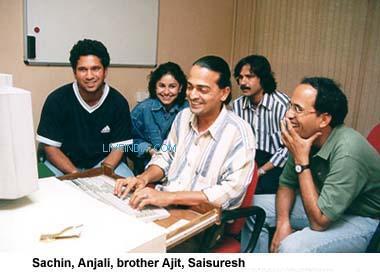 Tendulkar was born in a Rajapur Saraswat Brahmins family in Mumbai . His father, Ramesh Tendulkar,
Tendulkar was born in a Rajapur Saraswat Brahmins family in Mumbai . His father, Ramesh Tendulkar, who was a Marathi novelist, named him after his favorite music director, Sachin Dev Burman.
Tendulkar's elder brother, Ajit, encouraged him to play cricket. Tendulkar has two other
siblings: brother, Nitin, and sister, Savitai.
Tendulkar attended Sharadashram Vidyamandir (High School), where he began his cricketing
career under the guidance of his coach and mentor, Ramakant Achrekar. During his school
days he attended the MRF Pace Foundation to train as a fast bowler, but Australian fast bowler
Dennis Lillee, who took a world record 355 Test wickets, was unimpressed,
suggesting that Tendulkar focus on his batting instead
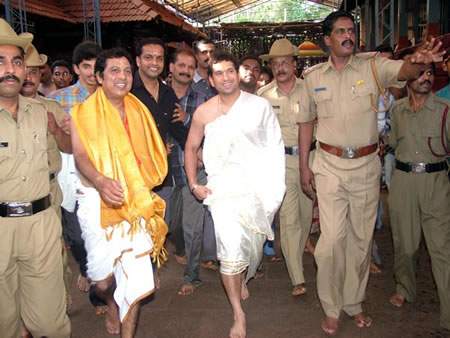
Tendulkar's Dream
Young Sachin had aspired of being a fast bowler. It was this dream that made him undertake trials at Chennai
based MRF pace academy, but his small stature proved to be a major hindrance to his aspiring career. ( THANK
GOD !!! else the WORLD would have been deprived of such a genius batsman. )
First step towards cricket
Tendulkar's sensational journey to cricket stardom sparked of when his brother Ajit made him meet Mr. R.
Achrekar ( Cricket Coach ). Sachin failed to perform in the first go which made him very nervous but his brother's
persuasion led Mr. Achrekar give him another chance.
 Tendulkar attended Sharadashram Vidyamandir (High School), where he began his cricketing
Tendulkar attended Sharadashram Vidyamandir (High School), where he began his cricketing career under the guidance of his coach and mentor, Ramakant Achrekar. During his school days,
he attended the MRF Pace Foundation to train as a fast bowler, but the fast bowling trainer there,
Dennis Lillee, suggested to him to "just focus" on his batting.
When Tendulkar was young, he would practice for hours with his coach. He would often get bored
of practicing. So his coach would put a one-Rupee-coin on the top of the stumps.
The bowler who dismissed Sachin would get the coin. If Sachin passed the whole session without
getting dismissed, the coach would give him the coin. Sachin says today that the
13 coins he won then are his most prized possessions.

It was his change of school to Shardashram Vidya Mandir in Dadar - close to Shivaji Park on his coach's advice
which marked a turn around in Sachin's career. He says," I use to bat in four nets at one strech. Whenever, I use
to get tired, Achrekar use to keep a one rupee coin on top of the stumps and say, "Anyone who gets him out will
take this coin. If no-one gets him, Sachin takes it." Tendulkar till date contributes this technique in being
instrumental for enhancing his concentration. He still treasures the 13 coins earned by him during the practice
sessions.
 |  |
Naughty Duo
Sachin and his best pal Vinod Kambli hold the World Record of 664 runs stand for Shardashram School in
inter-school tournament in 1988. Tendulkar candidly admits that the total would have never assumed mammoth
proportion had he and Kambli not ignored the man waving from the boundary with the coach's message to
declare.

Tendulkar's idol is the American Tennis superstar-John McEnore. During his young age, he argued and fought for
McEnore with his colony friends who supported Swedish Bjorn Borg. Sachin sported a head-band, sweat-band
and a tennis racquet showing his staunch loyalty towards his idol.
Family Quirks
Sachin's wife Anjali tends to become nervous while he bats, whereas his brother has become so superstitious
that he allows the family members to only watch the match recording.
On pre-mature and early exits, Sachin likes to take out his anger somewhere. He prefers to be left alone, till he
cools down.
Sachin Tendulkar 200
Sachin Tendulkar’s unbeaten 200 is a testimony to his fitness and commitment even as he heads for his 37th birthday. He is looking as fit as focused
and as formidable as he ever has, and his timing remains untouched by the passing years.
Having played till the age of 39, I know that discipline, good, healthy living and focus can add years to one’s career. What I lost in pace and stamina, I gained in control and guile. In Tendulkar’s case, too, he has smartly sorted out his game. He might not have the eye he had in his late 20s, or the speed — those are the peak years of every batsman. However, Tendulkar has compensated for those areas with excellent shot selection and placement.
I always maintain that Test cricket and one-day cricket are two different areas, one cannot be connected to the other. However, Tendulkar’s rich vein of form in the longer version seems to have relaxed him and given him the freedom to play in an unburdened manner. Though I did not see the knock, the statistics I have got are staggering.
The fact that he got the score in 147 balls itself is a huge achievement and by reaching 200 he bettered one of the best one-day knocks I have seen, by Saeed Anwar. The latter was one of the sweetest timers of the ball, and that knock in Chennai was when he was at the peak of his form. To have bettered that Tendulkar must have really turned on the magic with some scintillating shots.
There may be many who will say that the wicket helped strokeplay and that there was nothing in it for the bowlers. But no matter what the wicket is like, to stand through 50 overs and score 200 is a very, very special effort — an achievement that his contemporaries, Ricky Ponting and Brian Lara, would have been proud of.
If I had had to pick up a guy as the one to score the first one-day double ton, it would have been Virender Sehwag. He is young, belligerent and in unbelievable touch. However, it was his illustrious senior who pipped him at the post. Tendulkar seems to have rediscovered an exuberance and enjoyment which seems to have taken his game to a different level, and India would be hoping that he maintains this rhythm for some time.
This achievement would mean a lot to Tendulkar, even though he has many records to his name because every opener must have had an eye on this record. A double century has only been a theoretical possibility in limited overs so far, so in many ways Tendulkar has achieved something unusual. True, he has many feathers on his cap, but this one is a really special one. An absolutely phenomenal record by a truly phenomenal player.
Indian superstar Sachin Tendulkar has claimed his record innings can be surpassed after he became the first player to hit a double hundred in a one-day international.
Sachin Tendulkar Profile
When Tendulkar is on song, there is no more majestic sight in the cricketing world. The spectators at the stadium are on their feet cheering while all over the world, TV audiences are glued to the screen. He has scored heavily on all kinds of wickets the world over, in conditions which lesser mortals have not been able to master and against bowlers whom other batsmen have found it difficult to score off. Immensely gifted and blessed with an impeccable technique, Tendulkar's batting is a dream, combining timing, elegance and power. Mentally very strong, Tendulkar is best when confronted by a challenge - as he showed when mowing down Shane Warne in India in 1998. Captain during two short stints, Tendulkar has made it clear that he would prefer to concentrate on his batting and indeed, he seems to be getting better with every passing year. Scoring two double centuries in successive seasons and being the first to cross the 10,000 run barrier in ODIs is clear proof of this. The best thing from the fans' point of view - if not the bowler's - is that the entertainment, courtesy Tendulkar, is still at the intermission stage. Long may
`The King' continue to regale his willing subjects!
While his batting ranks him among the best in the world, he is also a part-time bowler and has played a crucial role as a leg spinner or a medium pace bowler who tends to break partnerships. He has more than a hundred wickets in ODIs and 35 in tests, though his bowling averages are above 40. He continues to perform well under the massive weight of expectation of hundreds of millions of cricket followers, in India and around the world, and most recently was named Player Of The Tournament in the 2003 Cricket World Cup.Incidentally, Sachin is the first batsman to be declared run out by third umpire in 1992 in South Africa.
Sachin Ramesh Tendulkar Statistics
Sachin Tendulkar
Sachin Tendulkar celebrates after reaching his world-record 35th Test century,
India v Sri Lanka, Delhi, December 10, 2005 Sachin Tendulkar created history by becoming the highest
century-getter as India laid the foundation for a mammoth first innings total in the second Test against Sri Lanka at the
Feroze Shah Kotla ground in New Delhi on Saturday. Tendulkar cracked an unbeaten 100 for his record 35th hundred,
the most in Test cricket, as India reached a strong 245 for three at stumps on the opening day.
Tendulkar's seventh ton against the visitors saw him surpass former captain and compatriot Sunil Gavaskar's tally of 34 for most number of hundreds in the all-time centurions list.
Sourav Ganguly was batting on 39 at the other end after playing the supporting role to Tendulkar to perfection.
It was also Tendulkar's 125th Test appearance, again matching Gavaskar and the second highest for an Indian.
Only Kapil Dev had played in more Tests, 131.
Tendulkar's innings helped India seize the initiative after skipper Rahul Dravid, suffering from illness, made a bold decision to
open the innings in the absence of Virendra Sehwag who was down with a throat infection. Tendulkar reached his
century with a single off Chaminda Vaas delivery.
His three figure mark came from 177 balls after 277 minutes at the crease, and contained 13 fours and a six. Tendulkar was somewhat circumspect in the initial phase of his innings and had to endure a testing spell of reverse swing bowling
by Fernando.
LiveIndia,com 10-12-2005.
My favourite fight is against Sachin
Andrew Flintoff, now the sports ambassador to that rapidly-evolving city in the Gulf, is an avowed fan of the Mumbai Indians skipper, who produced yet another match-winning knock, this time against the Kolkata Knight Riders on Monday.
"I love a fight against the best players in the world, and my favourite fight is against Sachin," said Flintoff during a one-on-one with TOI, when asked what egged him on more - rivalries like the Ashes or quality opposition. "I remember watching him while growing up, though he is not much older than me. Now that I've got the chance to play against him, I want to not just get him out but impress him as well," he added, sounding more like someone from Tendulkar's legion of adoring fans than the star all-rounder that he is.
Impress? "Yes, I want him to walk off thinking... Oh! Freddie can bowl, can't he? Or, if I got some runs, for him to think... Well, he can bat a bit," smiled the former England skipper who has now made Dubai his home.
"Obviously, that's because of the respect I have for him. I enjoy playing against the likes of Sachin, Dravid... It's a great test."
Having retired from Test cricket last year, Flintoff has moved with his family here to be nicely poised for the next phase of his career. "It's been a good move as a family and were spending a lot of quality time together," he said.
"It's been great professionally as well, with all the facilities and the (warm) weather just right for my knee rehab. India is only three hours away and it will allow me to come back between some of the IPL games. I want to play in different parts of the world - in South Africa, in Australia eventually. Where Dubai is on the map, it's perfectly placed," he added.
At 33 and recuperating from another surgery on his right knee, it would have been easy for Flintoff to blame it on "too much cricket" but he prefers to put things in perspective. "Pace bowling involves such an unnatural action - you're running in as hard as you can, you twist and turn, you slam your feet as hard as you can... Careers are going to become shorter, especially for the fast bowlers, but by then they’ll have earned many times more money than their predecessors. Imagine what Garfield Sobers would be worth in the IPL!"
Injuries and apparent decline
In the 2002 series in the West Indies, Tendulkar started well, scoring 79 in the first test, and 117 in the first innings of the second. Then, in a hitherto unprecedented sequence, he scored 0, 0, 8 and 0 in the next four innings, getting out to technical "defects" and uncharacteristically poor strokes. He returned to form in the last test scoring 41 and 86. However, India lost the series. This might have been the beginning of the "decline" phase in his career which lasted till 2006.
Tendulkar made 673 runs in 11 matches in the 2003 Cricket World Cup, helping India reach the final. While Australia retained the trophy that they had won in 1999, Tendulkar was given the Man of the Tournament award.
He continued to score heavily in ODI cricket that year, with two hundreds in a tri series involving New Zealand and Australia.
The drawn series as India toured Australia in 2003/04 saw Tendulkar making his mark in the last Test of the series, with 241* in Sydney, putting India in a virtually unbeatable position. He followed up the innings with an unbeaten 60 in the second innings of the test. Prior to this test match, he had had an unusually horrible run of form, failing in all six innings in the preceding three tests. It was no aberration that 2003 was his worst year in test cricket, with an average of 17.25 and just one fifty.
He scored an unbeaten 194 against Pakistan at Multan in the following series. The 194 was controversial in that he was stranded prior to reaching his double century as a result of a declaration by Rahul Dravid. In meeting with the press that evening, Tendulkar responded to a question on missing 200 against Pakistan by stating that he was disappointed and that the declaration had taken him by surprise.[52] Many former cricketers commented that Dravid's declaration was in bad taste.[53][54] The media noted at the time that the decision had apparently been made by Sourav Ganguly,[55] and Ganguly himself later admitted that it had been a mistake.[56] The controversy was put to rest when Rahul Dravid, Sachin Tendulkar and coach John Wright spoke to the media after the team's victory and stated that the matter was spoken internally and put to rest.[57]
Tennis elbow then took its toll on Tendulkar, leaving him out of the side for most of the year, coming back only for the last two tests when Australia toured India in 2004. He played a part in India's victory in Mumbai in that series with a fast 55, though Australia took the series 2–1.
On 10 December 2005 at Feroz Shah Kotla, Tendulkar scored his record-breaking 35th Test century, against the Sri Lankans.
In the test series in Pakistan in 2006, Sachin failed to get going in all three innings despite the pitches being flat tracks. In the third of those three innings, he was bowled comprehensively after making 26, and ended up on all fours. This prompted The Times of India to publish an article entitled "Endulkar" in which TOI opined that Tendulkar's batting prowess had declined and his career had slid permanently.
On 6 February 2006, he scored his 39th ODI hundred, in a match against Pakistan. He followed with a run-a-ball 42 in the second one-day international against Pakistan on 11 February 2006, and then a 95 in hostile, seaming conditions on 13 February 2006 in Lahore, which set up an Indian victory.
On 19 March 2006, after scoring an unconvincing 1 off 21 balls against England in the first innings of the third Test in his home ground, Wankhede, Tendulkar was booed off the ground by a section of the crowd,[58][59] the first time that he had ever faced such flak. Tendulkar was to end the three-Test series without a single half-century to his credit, and news of a shoulder operation raised more questions about his longevity. Tendulkar was operated upon for his injured shoulder. In July 2006, the Board of Control for Cricket in India (BCCI) announced that Tendulkar had overcome his injury problem following a rehabilitation programme and was available for selection, and he was eventually selected for the next series.
Tendulkar's comeback came in the DLF cup in Malaysia and he was the only Indian batsman to shine. In his comeback match, against West Indies on 14 September 2006, Tendulkar responded to his critics who believed that his career was inexorably sliding with his 40th ODI century. Though he scored 141*, West Indies won the rain-affected match by the D/L method.
In the preparation for the 2007 Cricket World Cup, Tendulkar was criticized by Greg Chappell on his attitude.[60] As per the report, Chappell felt that Tendulkar would be more useful down the order, while the latter felt that he would be better off opening the innings, the role he had played for most of his career. Chappell also believed that Tendulkar's repeated failures were hurting the team's chances. In a rare show of emotion, Tendulkar hit out at the comments attributed to Chappell by pointing out that no coach has ever suggested his attitude towards cricket is incorrect. On 7 April 2007, the Board of Control for Cricket in India issued a notice to Tendulkar asking for an explanation for his comments made to the media.[61]
At the Cricket World Cup 2007 in the West Indies, Tendulkar and the Indian cricket team, led by Rahul Dravid had a dismal campaign. Tendulkar, who was pushed to bat lower down the order by the Greg Chappell had scores of 7 (Bangladesh), 57* (Bermuda) and 0 (Sri Lanka). As a result, former Australian captain Ian Chappell, brother of the then Indian coach Greg, called for Tendulkar to retire in his column for Mumbai's Mid Day newspaper.[62]
During this period from about 2002 to 2006–7, Tendulkar's batting often seemed to be a shadow of its former self. He was inconsistent, and his big knocks mostly came in sedate, accumulative, uncharacteristic fashion. He seemed to have either cut out or lost the ability to play many shots, including the hook and pull and many other aerial strokes. He also developed a tendency to go without scoring much for long periods and become overtly defensive. While players such as Ponting and Kallis were at the peak of their careers, Sachin's seemed to be in terminal decline. There were several calls from him to retire too.
However after the 2007 World Cup, his career had a second wind and his consistency and form have returned.
Rise through the ranks
In 1996 against Pakistan in Sharjah, Indian captain Mohammed Azharuddin was going through a lean patch. Tendulkar and Navjot Singh Sidhu both made centuries to set a record partnership for the second wicket. After getting out, Tendulkar found Azharuddin in two minds to bat out. Tendulkar boosted Azharuddin to bat and Azharuddin subsequently unleashed 29 runs in mere 10 balls. It enabled India post a score in excess of 300 runs for the first time. India went on to win that match.
Tendulkar's rise continued when he was the leading run scorer at the 1996 Cricket World Cup, whilst scoring two centuries.[45] He was the only Indian batsman to perform in the infamous semi-final of that World Cup. When Tendulkar's wicket fell, the Indian batting lineup collapsed and India conceded defeat after the crowd began angry demonstrations.
This was the beginning of a period at the top of the batting world, culminating in the Australian tour of India in early 1998, with Tendulkar scoring three consecutive centuries. These were characterized by a premeditated plan to target Australian spinners Shane Warne and Gavin Robertson, to whom he regularly charged down the pitch to drive over the infield. This technique worked as India beat Australia. The test match success was followed by two scintillating knocks in Sharjah where he scored two consecutive centuries in a must-win game and then in finals against Australia tormenting Shane Warne once again. Following the series Warne ruefully joked that he was having nightmares about his Indian nemesis.[46] He also had a role with the ball in that series, including a five wicket haul in an ODI. Set 310 runs to win, Australia were cruising comfortably at 3 for 203 in the 31st over when Tendulkar turned the match for India taking wickets of Michael Bevan, Steve Waugh, Darren Lehmann, Tom Moody and Damien Martyn for just 32 runs in 10 overs.[47]
Tendulkar single-handedly won the ICC 1998 quarterfinal at Dhaka to pave way for India's entry into the semifinals, when he took four Australian wickets after scoring 141 runs in just 128 balls.
A chronic back problem flared up when Pakistan toured India in 1999, with India losing the historic Test at Chepauk despite a gritty century from Tendulkar himself. The worst was yet to come as Professor Ramesh Tendulkar, Tendulkar's father, died in the middle of the 1999 Cricket World Cup. Tendulkar flew back to India to attend the final rituals of his father, missing the match against Zimbabwe. However, he returned with a bang to the World cup scoring a century (unbeaten 140 off 101 balls) in his very next match against Kenya in Bristol. He dedicated this century to his father.[48]
Early years and personal life
Tendulkar attended Sharadashram Vidyamandir (High School),[1] where he began his cricketing career under the guidance of his coach and mentor, Ramakant Achrekar. During his school days he attended the MRF Pace Foundation to train as a fast bowler, but Australian fast bowler Dennis Lillee, who took a world record 355 Test wickets, was unimpressed, suggesting that Tendulkar focus on his batting instead.[19]
When he was young, Tendulkar would practice for hours on end in the nets. If he became exhausted, Achrekar would put a one-Rupee-coin on the top of the stumps, and the bowler who dismissed Tendulkar would get the coin. If Tendulkar passed the whole session without getting dismissed, the coach would give him the coin. Tendulkar now considers the 13 coins he won then as some of his most prized possessions.[20]
While at school, he developed a reputation as a child prodigy. He had become a common conversation point in Mumbai circles, where there were suggestions already that he would become one of the greats. His season in 1988 was extraordinary, with Tendulkar scoring a century in every innings he played. He was involved in an unbroken 664-run partnership in a Lord Harris Shield inter-school game in 1988 with friend and team mate Vinod Kambli, who would also go on to represent India. The destructive pair reduced one bowler to tears and made the rest of the opposition unwilling to continue the game. Tendulkar scored 326* in this innings and scored over a thousand runs in the tournament.[21] This was a record partnership in any form of cricket until 2006, when it was broken by two under-13 batsmen in a match held at Hyderabad in India.
When he was 14, Indian batting legend Sunil Gavaskar gave him a pair of his own ultra light pads. "It was the greatest source of encouragement for me," he said nearly 20 years later after surpassing Gavaskar's top world record of 34 Test centuries.[22] On 24 May 1995[23], Sachin Tendulkar married Anjali (born 10 November 1967), a paediatrician and daughter of Gujarati industrialist Anand Mehta. They have two children, Sara (born 12 October 1997), and Arjun (born 24 September 1999).[24]
Tendulkar sponsors 200 underprivileged children every year through Apnalaya, a Mumbai-based NGO associated with his mother-in-law, Annaben Mehta.[25]